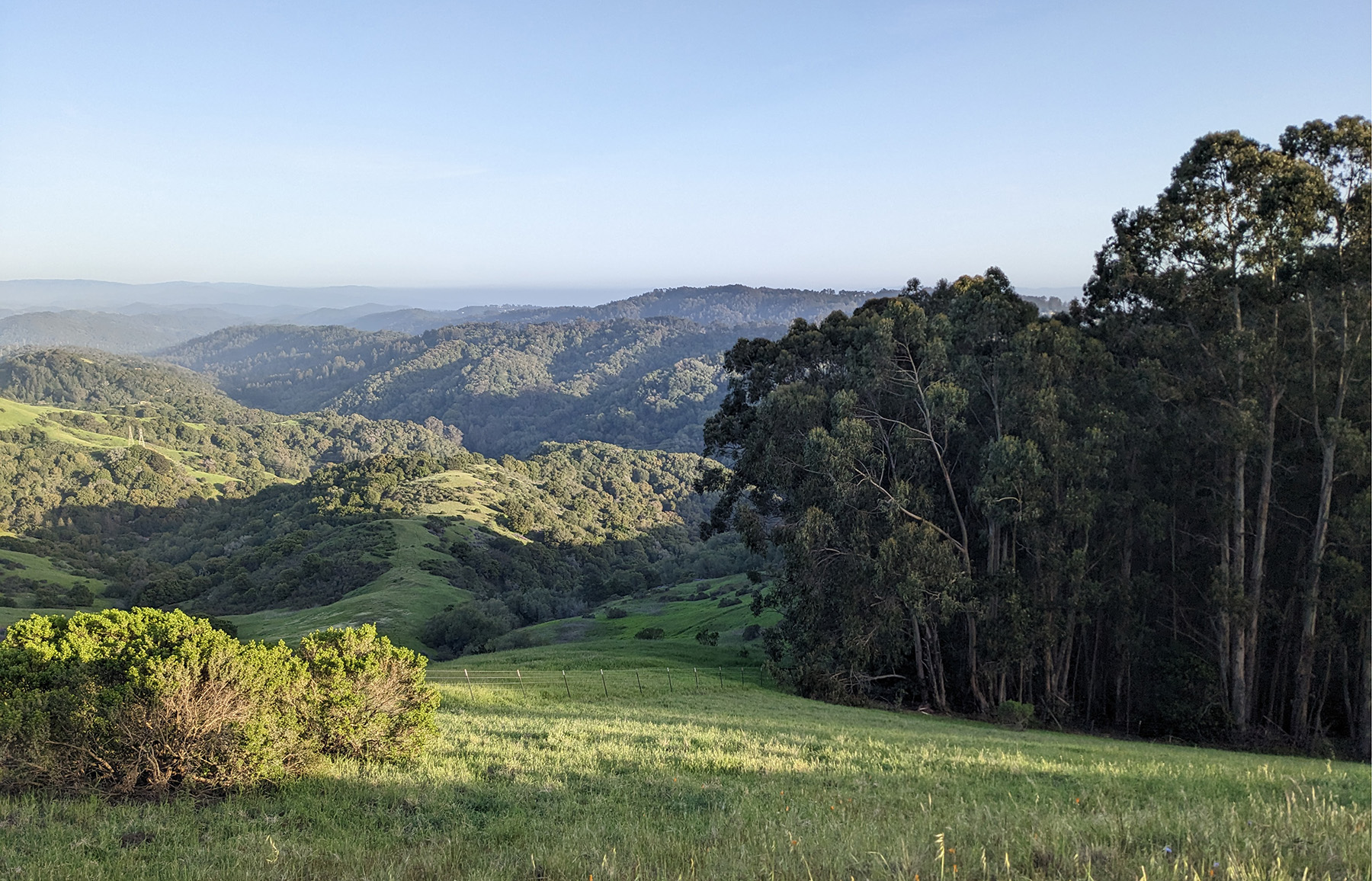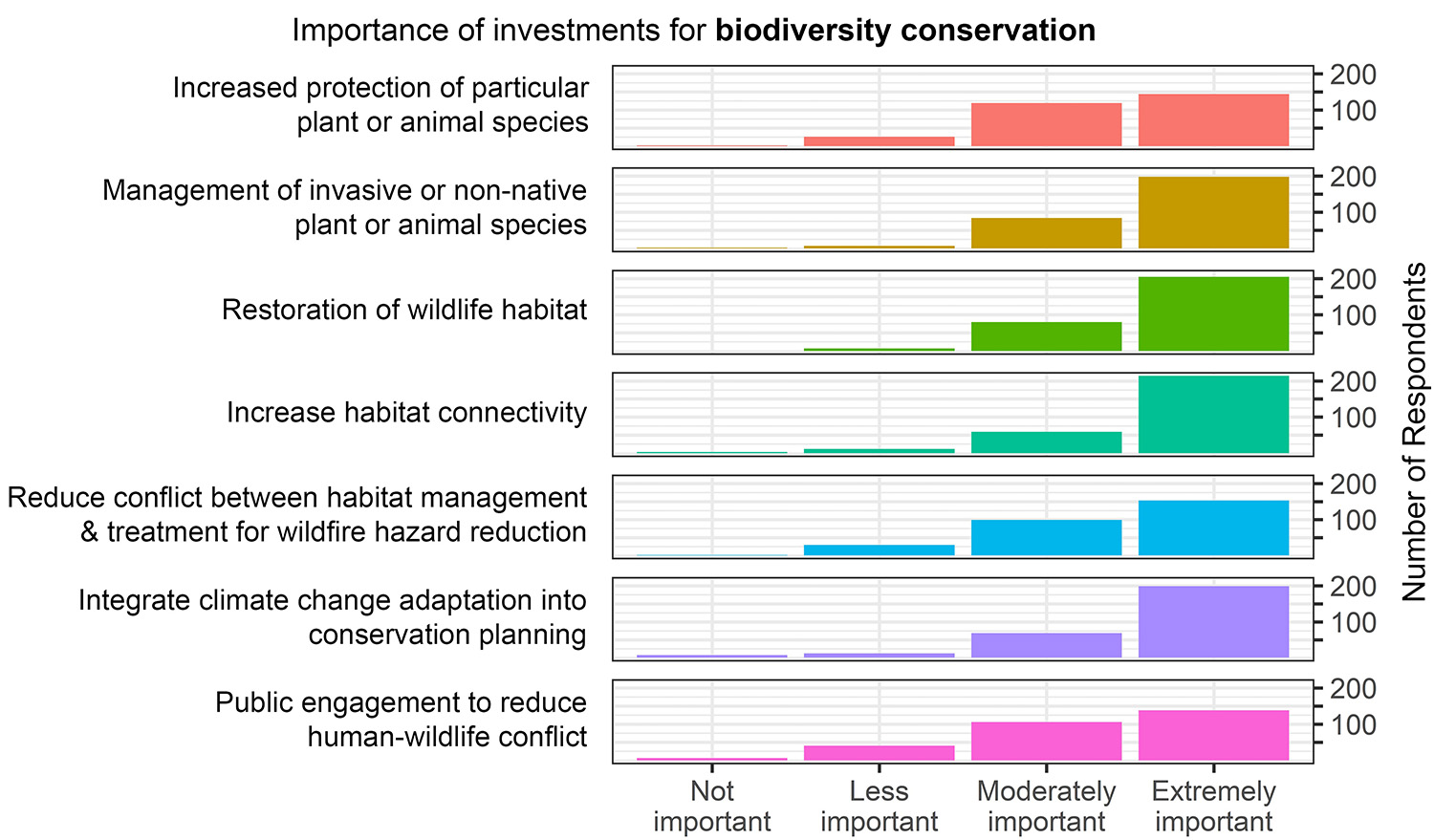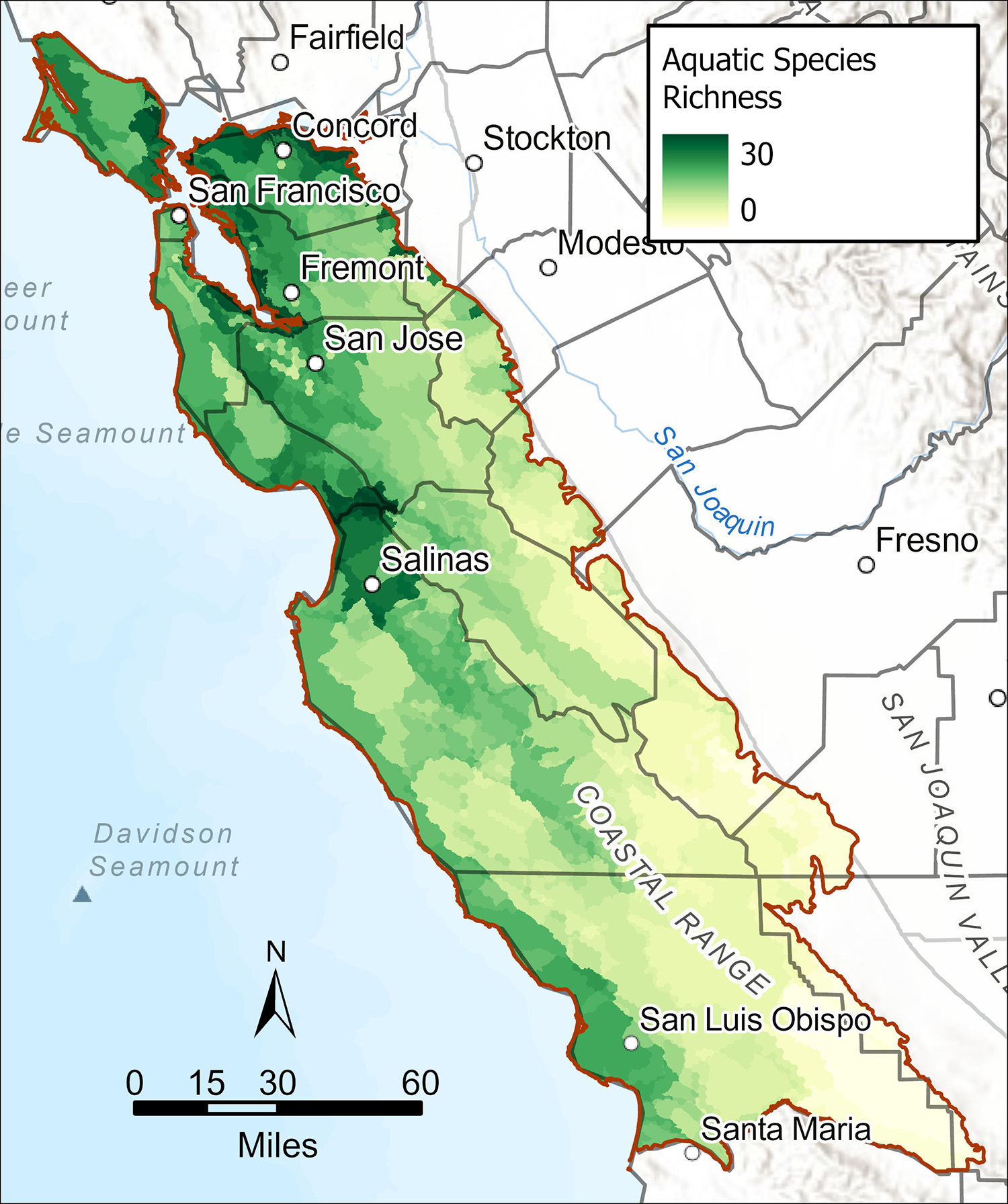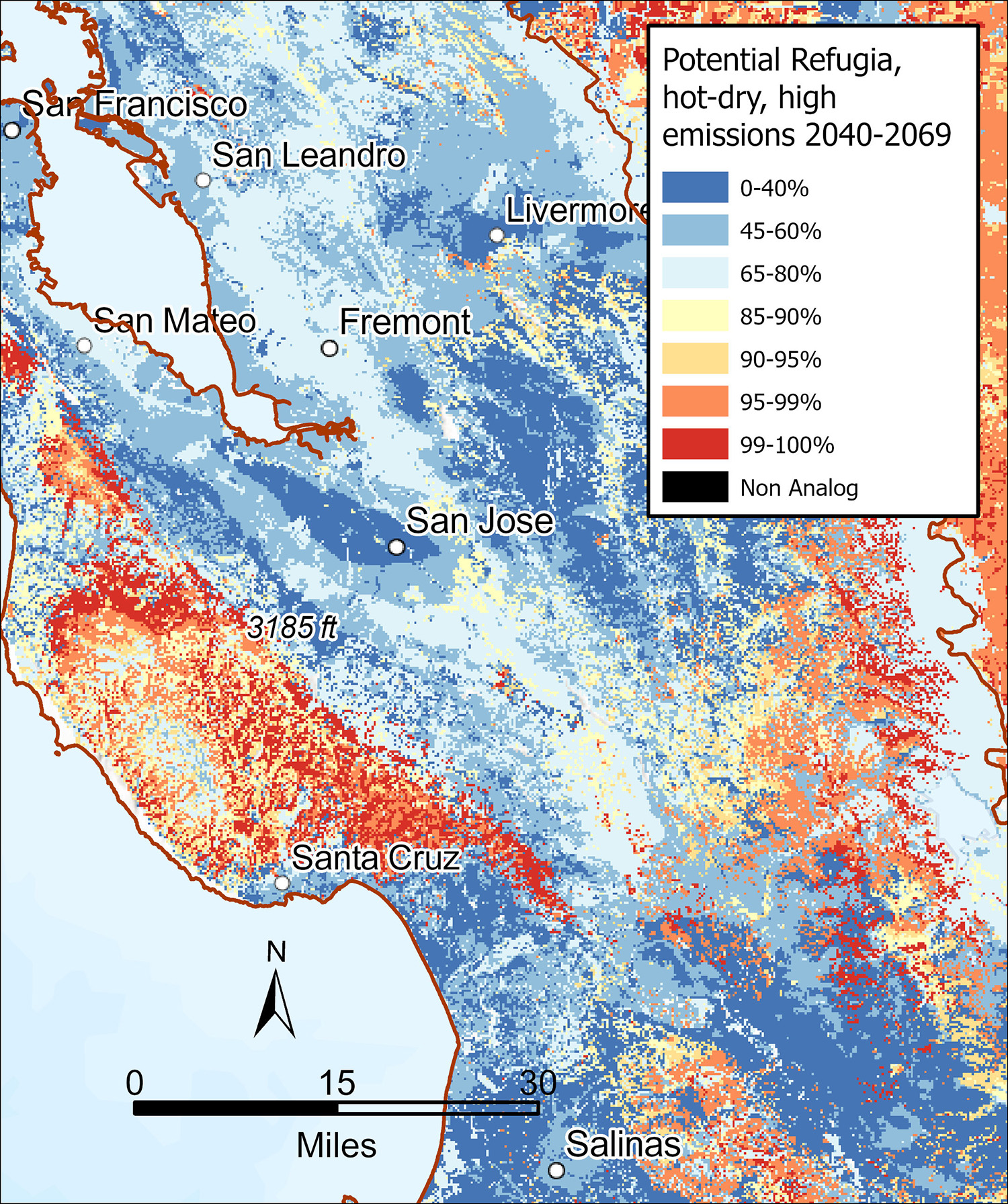Central Coast Regional Profile
Biodiversity Conservation

photo credit: Chelsea Andreozzi
Overview
The Central Coast region’s mosaic of ecosystems supports incredible biodiversity resources, including many endemic plant and animal species. Many sensitive species depend on Central Coast habitat and are threatened by long-term consequences of suppressing cultural burning and stewardship, including the impacts of changing fire regimes, such as the occurrence of higher intensity fire.
Though wildfires always alter a habitat, whether the changes sustain or degrade the habitat depends on how closely the fire characteristics match the historical patterns these systems evolved with. This applies to riparian habitat, where typically wet conditions reduce fire likelihood and intensity. Riparian forests can experience high severity if unusual conditions like drought, high fuel loads, exotic plant species, or wind-driven fires interact. When riparian habitat burns at high severity, the resulting loss of canopy cover can increase the temperature of aquatic habitat and make it unsuitable for species with sensitive thermoregulatory requirements, including native salmonids and endangered amphibian species, to complete their life cycles. A study of a California coastal stream found that one year after tree cover was lost to wildfire, mean daily stream temperatures of burned areas were elevated up to 1 °F compared to unburned areas and this increased metabolic stress on thermally-sensitive steelhead trout. As a result, those sections of stream sustained lower fish biomass due to starvation, mortality, or emigration to more suitable habitat. The loss of vegetation cover and burning of soil can also increase erosion and runoff following fire, affecting water quality. Post-fire landslides and debris flows can directly kill aquatic species and destroy breeding habitat. Increased sedimentation post-fire can also reduce the abundance and diversity of sensitive aquatic insects, which can have rippling effects for food webs.
Management actions that restore natural processes and the health of these ecosystems can increase resilience to wildfire and benefit biodiversity. However, current regulatory processes may inadvertently limit the pace and scale at which projects can occur. For example, fuel treatment projects that are done by state and local government agencies or which are funded by these agencies must be reviewed under the California Environmental Quality Act (CEQA). This includes projects that are intended to promote native habitat restoration and benefit sensitive species. The intention of regulatory processes is to minimize environmental impacts and protect biological resources by reviewing potential impacts before projects occur. However, projects often take at least 1-2 years to receive permits. During this time unplanned wildfire can impact the area that was going to be treated, or the costs and timeline of the regulatory process can become prohibitive to work being done. In response to this issue, the state of California launched an initiative called “Cutting the Green Tape” to increase the pace and scale of environmental restoration by streamlining permits and otherwise improving regulatory processes and policies for environmentally beneficial projects.
Vegetation treatments that benefit native habitat restoration can also come into conflict with other public goals, such as aesthetic values and species conservation. Managing non-native eucalyptus trees is a primary example of this. Millions of eucalyptus trees were planted in California between 1856 and the 1930s because its fast growth and large size suggested that it would be beneficial for lumber production, but the wood turned out to be unsuitable for this purpose. The trees persisted and, over time, invaded native ecosystems. Eucalyptus trees are more flammable and also shed more limbs, bark and leaves than native tree species, contributing to hazardous fuel accumulation for wildfires and higher risk of fire spread to adjacent areas. The combustion of eucalyptus vegetation is believed to have significantly contributed to the intensity and spread of the 1991 Oakland Hills fire. However, eucalyptus removal is a source of public contention because the trees are also valued for their aesthetic properties and the habitat some trees provide for biodiversity, such as endangered migratory monarch butterflies. Land managers in areas with significant eucalyptus stands must manage conflicting public interests to meet multiple objectives.
Stakeholder Perspectives

All potential areas of investment for achieving biodiversity conservation were considered on average to be at least moderately important. Top priorities were managing non-native or invasive species, restoring wildlife habitat, increasing habitat connectivity, and integrating climate change adaptation into conservation planning. Restoring habitat and increasing connectivity were not only on average higher, but also were rated as “extremely important” by most respondents.
Interview findings: Interviewees discussed how management to increase fire resilience for both ecosystems and communities can be more complicated due to many sensitive species being present in the region. The presence of threatened and endangered species can make it hard to get permits to do ecologically beneficial work or restrict when and how work can be done. In doing so, regulations that protect threatened and endangered species may promote single-species conservation rather than enabling holistic management. For example, several interviewees throughout the region discussed the challenge of removing exotic eucalyptus trees to reduce wildfire hazard because some of the trees provide habitat for monarch butterflies, which can lead to planned projects being halted by environmental litigation. Several interviewees recommended public education on the role of active vegetation management in promoting biodiversity and ecosystem health.
Resource Conditions


Assessing biodiversity can include metrics such as the richness of native species in different habitats, such as riparian areas (top), as well as the degree of climate change a habitat type is predicted to experience (bottom). Aquatic species richness measures the total number of potentially present native fish, aquatic invertebrates, aquatic amphibians, and aquatic reptiles in each watershed. In some regional watersheds, such as those in southern Santa Cruz or northern Contra Costa counties, as many as 30 native aquatic species may be present. Generally, coastal watersheds have higher species richness than inland watersheds. Climate exposure is a measure of the level of climate change that the dominant vegetation group of an area is expected to experience. It is calculated by projecting future climate conditions and comparing them to what the vegetation group currently experiences across its range. Areas with less than 80% exposure values are considered to be less stressed because climate conditions will be similar to what was historically commonly experienced. These less stressed areas might offer important refugia for the persistence of plants and animals threatened by climate change. In contrast, areas with >95% or “Non-Analog” exposure values are projected to be more stressed by climate change because that are at the edge or outside the range of what that vegetation type historically experienced. Predicting future climate exposure can help resource managers to adaptively manage for climate change.
